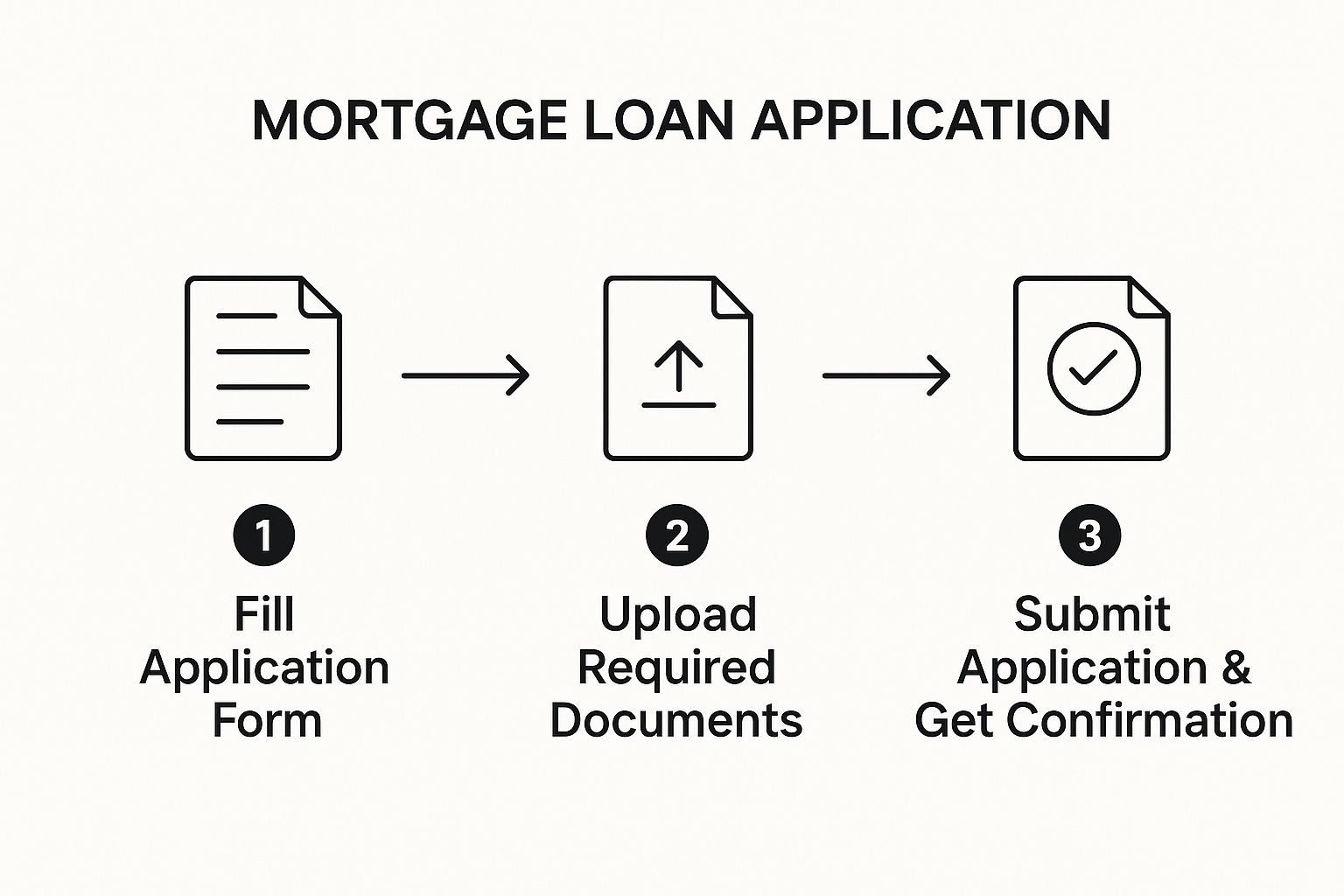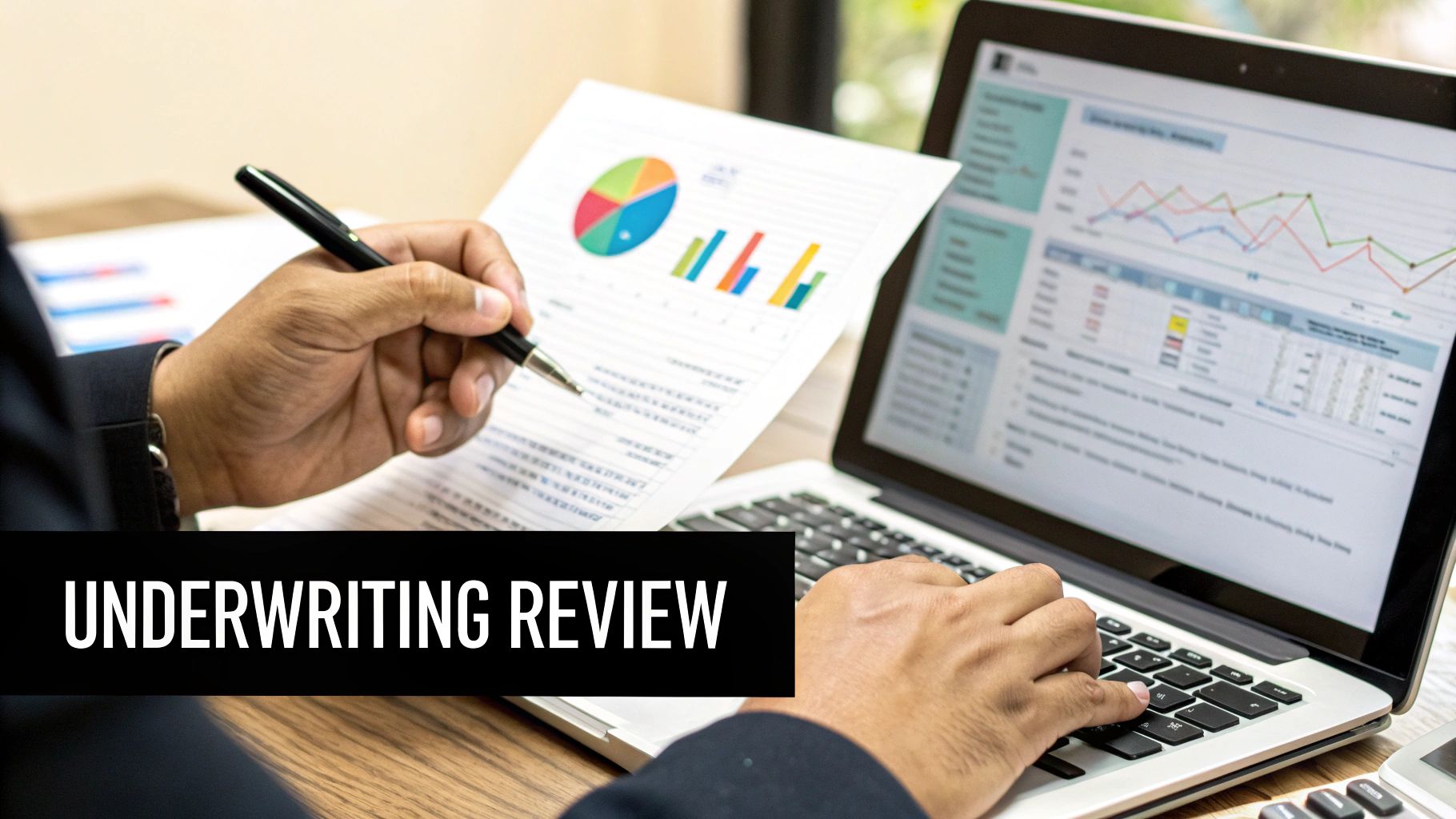Your Guide to Mortgage Loan Process Steps
August 13, 2025
Master the mortgage loan process steps with our expert guide. Navigate from pre-approval to closing with confidence and secure your dream home.

Buying a home can feel like a monumental task, but I've learned from years of experience that understanding the mortgage process from the inside out is the single best way to turn that overwhelm into a clear, step-by-step plan. It all follows a predictable path: pre-approval, the house hunt, the official application, underwriting, the appraisal, and finally, closing day. Getting a handle on this sequence right from the start is your biggest advantage.
Your Path to Homeownership Starts Here

Think of this guide less like a technical manual and more like a real-world roadmap. I'm going to walk you through the entire journey—from getting your financial ducks in a row to finally getting those keys in your hand. My goal is to give you a practical, behind-the-scenes look at what lenders really care about, how to get ready for each stage, and why knowing the game plan gives you a serious leg up.
We’re going to pull back the curtain on every step. This way, you can make smarter, more confident decisions, which is especially important in today's constantly shifting market.
Understanding the Modern Mortgage Environment
The mortgage world isn't set in stone. It's always moving, reacting to the economy, interest rates, and new technology. For example, after a massive $4 trillion in loans were originated back in 2021, the market completely changed course as interest rates shot up.
This kind of volatility really shines a light on how crucial government-backed programs like VA, FHA, and USDA loans are. They act as a stabilizing force, opening doors to homeownership that might have otherwise closed. If you want to dive deeper into how global markets and government policies affect mortgage rates, this in-depth Ginnie Mae analysis is a fantastic resource.
Knowing the bigger economic picture isn't just trivia—it helps you understand why rates are what they are and what kind of loan programs might be out there to help you.
Setting the Stage for Success
Before you ever fill out a single loan application, the real work begins with exploring the market. A smart first move is to explore available real estate listings to get a feel for what’s out there and what homes actually cost in your target neighborhoods. This simple step grounds your financial planning in reality, not just wishful thinking.
Ultimately, a smooth home-buying experience comes down to preparation. By understanding what’s coming, you go from being just another hopeful buyer to a well-prepared applicant that lenders take seriously. Let's build that foundation together.
Your First Power Move: Getting Pre-Approved
Before you even start scrolling through listings and dreaming about that perfect kitchen, there’s a critical first step you can't afford to skip: getting pre-approved for your mortgage. Honestly, think of this less as a suggestion and more as your secret weapon in today's competitive housing market. A pre-approval letter is what separates the window shoppers from the serious contenders.
It’s easy to mix up pre-qualification with pre-approval, but they’re not the same thing at all. A pre-qualification is basically a quick, informal chat where you give a lender some numbers off the top of your head. It’s a decent starting point to get a ballpark idea of what you might afford, but it carries almost no weight with sellers.
A pre-approval, however, is the real deal. This is where a lender takes a deep dive into your finances and gives you a conditional commitment for a specific loan amount. It’s a powerful signal to everyone involved that you’re a credible buyer ready to make a serious offer.
What Lenders Look At During Pre-Approval
To get that coveted pre-approval letter, you'll need to open up your financial life to the lender. They want to see everything to feel confident in your ability to repay a massive loan. My advice? Get all your documents lined up before you even talk to a loan officer. It makes the entire process faster and far less stressful.
To help you get organized, I’ve put together a checklist of the essential documents lenders almost always ask for. Having these ready to go shows you’re on top of your game.
Key Documents for Mortgage Pre-Approval
Once you have this paperwork scanned and ready, you're in a fantastic position to move quickly.
My Biggest Piece of Advice: Once you start this process, freeze your finances. Seriously. Don't open new credit cards, don't co-sign for your cousin's car, and try not to switch jobs. Lenders get nervous about sudden changes, and stability is the name of the game.
The journey from gathering your documents to submitting your application is actually pretty straightforward, as you can see below.

The real work is in the preparation. Once you’ve done that, the rest flows much more smoothly.
Using Your Pre-Approval to Win the Deal
After the lender has combed through your finances and given you the green light, you’ll receive that all-important pre-approval letter. This isn't just another piece of paper—it’s pure negotiating leverage. It clearly states the loan amount you're approved for, which empowers you to shop for homes confidently within a realistic budget.
When you find the one, attaching that pre-approval letter to your offer immediately puts you at the top of the pile. It tells the seller your financing is solid, which drastically reduces the risk of the deal falling apart later. In a market where sellers are getting multiple offers, that peace of mind can be the single factor that gets yours accepted.
To get a complete rundown of this crucial first step, check out our essential guide to getting pre-approved for a home loan. It digs even deeper to help you prepare effectively and start your journey on solid ground.
From an Accepted Offer to a Formal Application
That feeling when a seller accepts your offer? It's pure exhilaration. But after you pop the champagne and do a little victory dance, the reality sets in. The real work is just beginning, and the clock is officially ticking. It's time to transition from that preliminary pre-approval to a full-blown, formal loan application.
This is the part of the journey where everything gets double-checked and verified. Your pre-approval was based on the information you gave your lender, but now they need to prove it all. You'll be working hand-in-hand with your loan officer to get this done and, just as importantly, to lock in your interest rate.
Tackling the Official Loan Application
The main event here is filling out the Uniform Residential Loan Application, which you might hear referred to as Fannie Mae Form 1003. It sounds a lot more intimidating than it is. The good news? If you did a thorough job gathering your documents for pre-approval, you've already done most of the heavy lifting.
This form is where you'll officially record all the details you've discussed. You’ll need to provide specifics on:
- The Property: The complete address and, of course, the final sales price.
- Your Financial Picture: A crystal-clear breakdown of your income, assets (checking, savings, 401k), and any existing debts (student loans, car payments, credit cards).
- Your Work Life: A solid two-year history of your employment, complete with company names and addresses.
- The "Declarations": This is a list of yes-or-no questions. They cover important ground, like past bankruptcies or foreclosures, and whether any part of your down payment is coming from a borrowed source.
My best advice here is to be an open book. Don't fudge any numbers or try to hide anything. Even a small discrepancy between what you put on this form and what your bank statements show can create major headaches and delays down the line in underwriting.
The Loan Estimate: Your Most Important Document
Once you've submitted that application, federal law requires your lender to send you a Loan Estimate (LE) within three business days. This is a standardized, three-page document, and I can't stress this enough: it is one of the most critical pieces of paper you will receive in this entire process.
My Two Cents: Seriously, don't just glance at your Loan Estimate. This is your single best tool for comparing loan offers and making sure you aren't getting taken for a ride. A few minutes of focused review right now can literally save you thousands of dollars and prevent a world of future stress.
Think of the LE as the official price tag for your mortgage. It lays out your interest rate, your estimated monthly payment, and a detailed list of your closing costs in black and white.
How to Actually Read Your Loan Estimate
The LE is designed to be easy to follow, but you have to know what you're looking for. Let's break it down.
Page 1: The Big Picture
This is your at-a-glance summary. It confirms your loan term (30 years), loan type (Fixed-Rate, for example), and interest rate. Look closely for a crucial detail: whether your rate is locked and for how long. It also gives you the big numbers you care about most—your estimated monthly payment and your estimated "cash to close."
Page 2: Where the Money Goes
This page is the nitty-gritty breakdown of all the fees. It's split into a few key boxes:
- A. Origination Charges: These are the fees your lender charges directly for setting up the loan. This is where you’ll see any application fees or "points" you might be paying to buy down your interest rate.
- B. Services You Cannot Shop For: These are third-party costs for things you have to use, like the property appraisal and the fee to pull your credit report.
- C. Services You Can Shop For: Pay attention here! This section includes fees for services like title insurance, pest inspections, and surveys. You are not obligated to use the provider your lender suggests, and you can often save a nice chunk of change by shopping around for these yourself.
Page 3: Apples-to-Apples Comparisons
The final page gives you powerful metrics for comparing different loan offers. You'll find the Annual Percentage Rate (APR), which reflects the true cost of borrowing once fees are factored in, and the Total Interest Percentage (TIP). The TIP is an eye-opener—it shows you the total amount of interest you’ll pay over the entire life of the loan.
Getting a firm handle on the application and your Loan Estimate is a huge step. It shifts you from being just a hopeful homebuyer to a truly informed borrower, giving you the confidence to move forward and lock down the financing for your new place.
Into Underwriting and Appraisal: The Home Stretch

Alright, you’ve submitted your formal application. Now the real waiting game begins. This is where your file moves into underwriting, which can feel like a black box for a lot of homebuyers. Essentially, an underwriter—the lender's financial detective—is about to put your entire financial life under a microscope.
At the same time, the lender kicks off the home appraisal. While the underwriter is digging into your finances, a licensed appraiser is sent to make sure the house is actually worth what you've agreed to pay. Both of these have to come back clean for your loan to move to the closing table. It can be a nail-biting period, but knowing what's going on behind the curtain makes it a whole lot easier.
What Is Underwriting, Really?
Think of the underwriter as the final decision-maker. Their job is to protect the lender's investment by confirming you're a good risk. They'll go through every document you submitted, cross-checking everything to ensure it all lines up.
From my experience, underwriters zero in on three key things—I call them the "Three C's":
- Capacity: Do you truly have the income and stable employment to handle the monthly mortgage payment? Your debt-to-income (DTI) ratio gets a hard look here.
- Credit: They’ll pull your credit report and analyze your history. They're looking for a consistent, reliable pattern of paying your debts on time.
- Collateral: The house itself is the collateral. The underwriter needs the appraisal to confirm the property's value is high enough to back the loan amount.
It is completely normal to get a list of questions or requests for more documents from the underwriter. This is called a conditional loan approval, and it's a good sign! It means you're on track to be approved if you can provide a few more things, like a recent pay stub or a letter explaining a large deposit. Don't freak out. Just get them what they need, and do it quickly.
Understanding The Home Appraisal
While the underwriter has their head in your paperwork, an independent, state-licensed appraiser is focused on the property. Their sole job is to determine the home's fair market value. Why? Because the lender needs to know that if you ever stop making payments, they can sell the house and get their money back.
The appraiser will visit the home, measure it, note its condition, and take a lot of photos. Then they'll find recently sold properties in the neighborhood that are similar to yours—we call these "comps." All of this gets compiled into a detailed report that goes straight to the underwriter.
In a perfect world, the appraisal comes in at or above your purchase price. This gives the lender the confidence to move forward.
But what if the appraisal comes in low? It’s a hurdle, but not necessarily a deal-killer. Let's say you offered $400,000 for a home, but the appraiser values it at $385,000. That creates a $15,000 gap, because the lender will only finance based on the lower value.
Here’s how you can handle it:
- Renegotiate: You can go back to the seller and ask them to lower the price to the appraised value of $385,000.
- Pay the Difference: If you have the cash, you can bring that extra $15,000 to closing on top of your down payment.
- Challenge the Report: It’s tough, but you can work with your loan officer to dispute the appraisal by providing better comps the appraiser might have missed.
- Walk Away: If your contract has an appraisal contingency (and it should!), you have the right to cancel the deal and get your earnest money back.
The key to getting through this phase is to be organized, stay in close contact with your loan officer, and respond to any requests immediately. A proactive mindset here will keep things moving smoothly toward the best day of all—closing day.
The Final Lap to Closing Day
You’ve navigated the maze of underwriting and appraisal, and I can tell you from experience, the finish line is genuinely within reach. This last leg of the journey is all about final checks, getting your ducks in a row, and, finally, signing the papers that make it all official.
The most important milestone you'll hit here is receiving your Closing Disclosure, or CD. Lenders are legally required to get this five-page document into your hands at least three business days before you’re scheduled to close. This isn't just a suggestion; it's a mandatory cooling-off period designed to give you time to breathe and review everything without feeling rushed.
Mastering the Closing Disclosure
Think of the Closing Disclosure as the final, locked-in version of the Loan Estimate you got at the very beginning. Your number one job right now is to pull out that old Loan Estimate and compare it to this new Closing Disclosure, line by line. Seriously. You're hunting for any surprises or last-minute changes to your loan.
This is your last real opportunity to flag any mistakes. I always tell my clients to focus on these key areas:
- Loan Amount and Interest Rate: Is it the exact rate you locked in? No surprises here.
- Monthly Payment: Does the PITI (principal, interest, taxes, and insurance) match what you were anticipating?
- Cash to Close: This is the big one. It's the final, precise dollar amount you need to have ready for your closing appointment.
- Loan Costs: Flip to Page 2 of your Loan Estimate and compare the lender fees to those on the CD. Small shifts in third-party costs are normal, but your lender’s own origination charges should not have gone up.
If something looks off—even a little bit—call your loan officer immediately. Don't wait until you're sitting at the closing table. A quick question now can save you a world of stress later and ensure the appointment goes smoothly.
Preparing for Your Closing Appointment
Closing day is the moment it all becomes real. It’s an exciting time, but it’s also a formal meeting with a mountain of paperwork. Knowing what’s coming makes the whole thing feel much less intimidating.
Most of the time, you'll meet at a title company or an attorney's office. You'll be in the room with a closing agent (the person running the show) and likely your real estate agent. The sellers might be there, or they might sign their papers at a different time.
You're going to sign a lot of documents, but pay special attention to these two:
- The Promissory Note: This is your legally binding promise to repay the loan. It clearly states your loan amount, interest rate, and all the repayment terms.
- The Deed of Trust (or Mortgage): This is the document that uses your new home as collateral for the loan. It gives the lender the right to foreclose if you don't make your payments.
Before you head out the door, it's smart to have all your bases covered. For a truly seamless experience, we put together a guide specifically on understanding loan closures and how to navigate this final step.
This entire process is part of a massive, constantly evolving industry. The global mortgage loan service market was recently valued at around $10.5 trillion and is projected to hit $18.2 trillion in the near future. This isn't just random growth; it's fueled by new tech making the mortgage process better for everyone. If you're curious about what's next, you can discover more insights about the mortgage market's future and how technology is changing the game.
To make sure your closing day is a celebration, not a scramble, just follow this simple checklist:
- Confirm Your "Cash to Close" Amount: Get the final, exact number from your closing agent or loan officer a day or two beforehand.
- Arrange Your Funds: You'll need a cashier's check or a wire transfer for your down payment and closing costs. They won't take a personal check.
- Bring Your ID: A valid government-issued photo ID is a must. A driver’s license or passport works perfectly.
- Allow Plenty of Time: A typical closing takes about an hour. Give yourself a cushion so you can read what you're signing without feeling rushed.
Walking into that appointment feeling prepared and confident is the best way to cap off your home-buying journey. Once the papers are signed and the funds are transferred, you’ll get the keys—the ultimate reward for all your hard work.
Answering Your Top Mortgage Questions

Even the most straightforward road map can have a few surprise detours. When it comes to getting a mortgage, questions aren't just common—they're a given. This is where we tackle the concerns I hear most often from homebuyers, turning that knot of confusion in your stomach into pure confidence.
Think of this as your personal FAQ for the most nerve-wracking parts of the mortgage loan process. We’ll cover everything from what happens when rates shift to how much cash you actually need to have on hand, so you can handle anything that comes your way.
What Happens If Interest Rates Change After I Get Pre-Approved?
This is a big one. It's probably the question I get asked more than any other, and for good reason. You get pre-approved at a great rate, then you see on the news that rates are starting to climb. It’s enough to make anyone a little panicked.
Here’s the thing you absolutely need to remember: a pre-approval rate is not locked in. It’s just a snapshot of the market on the day your lender pulled your info. That rate is purely hypothetical until you have a signed purchase contract on a specific house.
As soon as your offer is accepted, that’s your cue to work with your loan officer to officially lock your interest rate. A rate lock is a lender's promise to give you a specific rate for a set period, usually 30 to 60 days. This is your shield, protecting you from market swings while your loan makes its way through underwriting to the closing table.
My two cents: The moment you have an accepted offer, talk to your loan officer about your rate lock strategy. I've seen clients hesitate for a day or two and miss out on a lower rate. Timing is everything here.
Can I Make a Big Purchase While My Loan Is in Process?
I’m going to be blunt: please don't. I have personally seen this mistake derail more home purchases than almost any other. From the moment you apply for your loan, your entire financial picture is essentially under a microscope.
Lenders perform a final credit check and re-verify your employment and assets right before you close. Buying a new car, financing thousands of dollars in furniture, or even opening a new store credit card can throw a major wrench in the works.
Why is this so risky? These actions can:
- Spike your debt-to-income (DTI) ratio: That new car payment could easily push your DTI over the lender's strict limit, leading to a last-minute loan denial.
- Drop your credit score: A new hard inquiry on your credit report can cause your score to dip just enough to matter.
- Drain your cash reserves: Making a large cash purchase eats into the very funds the lender verified you have for your down payment and closing costs.
I know how tempting it is to start planning for the new place, but please, hold off on any big financial moves until after you have the keys in your hand.
How Much Cash Do I Really Need at Closing?
This is another area where a little clarity goes a long way. Your "cash to close" is much more than just your down payment. It’s the total amount of money you need to wire or bring as a cashier’s check to the closing table, and it’s made up of a few different pieces.
Your total cash to close is a combination of these key items:
- Your Down Payment: This is the slice of the purchase price you pay upfront. It can range from 3% to 20% (or more) of the home's sale price, depending on your loan type.
- Closing Costs: These are the fees for all the services required to finalize your loan, like the appraisal, title search, and lender fees. They typically run between 2% to 5% of your total loan amount.
- Prepaid Items: Think of these as paying some bills in advance. You'll usually pay for your first year of homeowner's insurance and set aside several months of property taxes in an escrow account.
To see how all these pieces fit together over time, check out our guide on the home-buying process timeline. It gives you a great overview of when these costs pop up. Your final Closing Disclosure, which you'll receive a few days before closing, will spell out the exact, to-the-penny amount you need.
Keeping an Eye on Market Trends
Having a sense of the bigger picture helps you understand why things are the way they are. The mortgage industry is always shifting, and right now, projections show a real rebound in home buying.
For example, the Mortgage Bankers Association (MBA) is forecasting an 8% increase in purchase originations, expected to hit $1.4 trillion. That’s a 14% jump in the total number of mortgages being made. This growth is largely because interest rates are beginning to stabilize and strong demographic trends are pushing more people into the market.
Knowing this helps you understand the "why" behind rate movements and lender policies. It empowers you to navigate the mortgage loan process not just as a participant, but as a savvy, informed buyer.
At Tiger Loans Inc, we believe an informed borrower is an empowered one. Our whole mission is to pull back the curtain on the mortgage process, giving you the clarity and support you deserve. Whether this is your first home or your fifth, our team is here to guide you every single step of the way.
Ready to see what’s possible? Explore your options and get started on your journey at https://www.tigerloans.com.

Alex Chen

Alex Chen













Get in touch with a loan officer
Our dedicated loan officers are here to guide you through every step of the home buying process, ensuring you find the perfect mortgage solution tailored to your needs.
Options
Exercising Options
Selling
Quarterly estimates
Loans
New home

Stay always updated on insightful articles and guides.
Every Monday, you'll get an article or a guide that will help you be more present, focused and productive in your work and personal life.





.png)
.png)
.png)
.png)
.png)
.png)
.png)
.png)
.png)
.png)
.png)
.png)
.png)
.png)
.png)
.png)
.png)
.png)
.png)
.png)
.png)
.png)